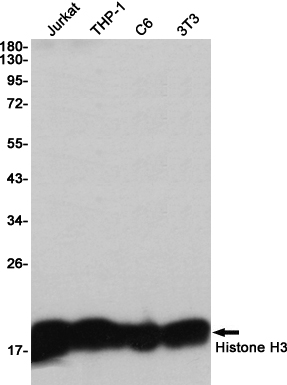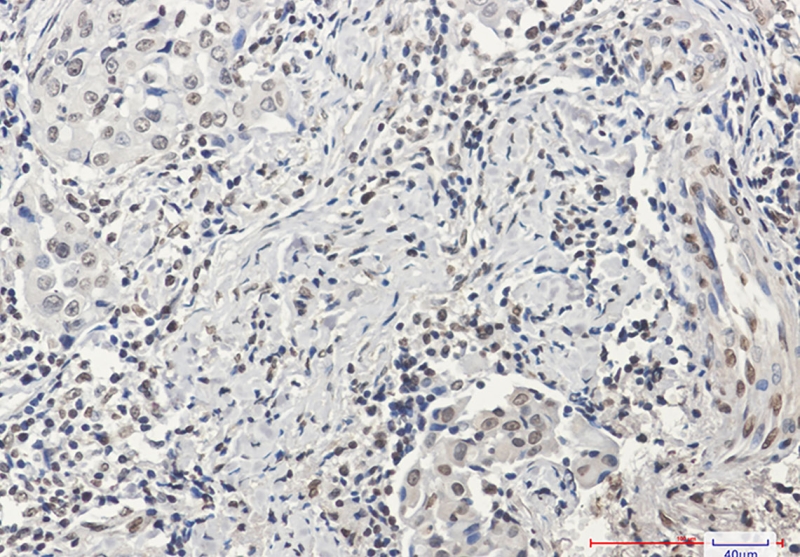

| WB | 1/500-1/1000 | Human,Mouse,Rat |
| IF | 咨询技术 | Human,Mouse,Rat |
| IHC | 1/50-1/100 | Human,Mouse,Rat |
| ICC | 技术咨询 | Human,Mouse,Rat |
| FCM | 咨询技术 | Human,Mouse,Rat |
| Elisa | 咨询技术 | Human,Mouse,Rat |
| Aliases | H3 histone; family 3A; H3 histone; family 3B (H3.3B); H3.3A; H3.3B; H33; H3F3; H3F3A; H3F3B; Histone H3.3 |
| Entrez GeneID | 8350 |
| WB Predicted band size | Calculated MW: 15 kDa; Observed MW: 15 kDa |
| Host/Isotype | Rabbit IgG |
| Antibody Type | Primary antibody |
| Storage | Store at 4°C short term. Aliquot and store at -20°C long term. Avoid freeze/thaw cycles. |
| Species Reactivity | Human,Mouse,Rat |
| Immunogen | A synthetic peptide of human Histone H3 |
| Formulation | Purified antibody in TBS with 0.05% sodium azide,0.05%BSA and 50% glycerol. |
+ +
以下是3篇关于Histone H3抗体的参考文献(名称、作者及摘要概括):
1. **文献名称**:*"High-resolution profiling of histone methylations in the human genome"*
**作者**:Barski, A. et al. (2007)
**摘要**:该研究利用ChIP-seq技术结合特异性Histone H3抗体(如H3K4me3、H3K27me3等),在全基因组范围内绘制了组蛋白修饰图谱,揭示了不同甲基化修饰在基因调控中的分布规律,为表观遗传学研究提供了关键工具和数据库。
2. **文献名称**:*"Mitosis-specific phosphorylation of histone H3 initiates primarily within pericentromeric heterochromatin during G2 and spreads in an ordered fashion coincident with mitotic chromosome condensation"*
**作者**:Hendzel, M.J. et al. (1997)
**摘要**:该研究通过H3S10磷酸化(H3S10ph)特异性抗体,揭示了组蛋白H3在有丝分裂早期的磷酸化动态,证明该修饰起始于着丝粒异染色质区域,并与染色体凝缩过程密切相关,为细胞周期调控机制提供了证据。
3. **文献名称**:*"Role of histone H3 lysine 27 methylation in Polycomb-group silencing"*
**作者**:Cao, R. et al. (2002)
**摘要**:该研究开发并验证了H3K27me3特异性抗体,证明该修饰是Polycomb抑制复合体(PRC2)介导基因沉默的关键标志,并阐明了其在干细胞分化和发育中的调控作用,推动了表观遗传学领域对基因沉默机制的理解。
4. **文献名称**:*"An assessment of histone-modification antibody quality"*
**作者**:Egelhofer, T.A. et al. (2011)
**摘要**:该研究系统评估了多种商业化和实验室自制的组蛋白修饰抗体(包括H3K4me3、H3K9ac等)的特异性,通过肽阵列和ChIP-seq交叉验证,揭示了部分抗体的非特异性结合问题,强调了抗体验证在表观遗传学研究中的重要性。
以上文献涵盖了Histone H3抗体的应用开发、功能研究及质量控制,适用于染色质分析、疾病机制探索及实验方法优化等领域。
Histone H3 antibodies are essential tools in epigenetics and chromatin biology research. Histones, including H3. are core proteins around which DNA wraps to form nucleosomes, playing critical roles in chromatin structure regulation and gene expression. Histone H3 undergoes various post-translational modifications (e.g., methylation, acetylation, phosphorylation) that influence DNA accessibility, transcriptional activity, and cellular processes like DNA repair and replication. Antibodies targeting specific H3 modifications (e.g., H3K4me3. H3K27ac, H3S10ph) or mutations (e.g., H3K27M in gliomas) enable researchers to study epigenetic mechanisms, cell differentiation, and disease pathogenesis.
These antibodies are widely used in techniques such as chromatin immunoprecipitation (ChIP), Western blotting, and immunofluorescence. For example, H3K27me3 antibodies help identify Polycomb-repressed regions, while H3K9ac antibodies mark active enhancers. Mutant-specific H3 antibodies (e.g., against H3G34R/V) have diagnostic value in cancers like pediatric glioblastoma. Additionally, histone H3 variants (e.g., H3.3) and their roles in replication-independent chromatin assembly are studied using isoform-specific antibodies.
Given their importance in linking chromatin dynamics to diseases like cancer and neurological disorders, Histone H3 antibodies remain indispensable for both basic research and clinical diagnostics.
×